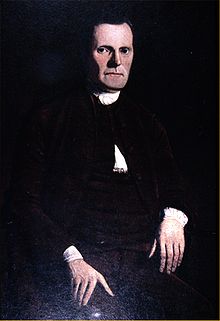Roger Sherman

Roger Sherman (born April 19, 1721 in Newton , Province of Massachusetts Bay , † July 23, 1793 in New Haven , Connecticut ) was an American lawyer and politician and co-author of the Declaration of Independence of the United States . He was also US Senator for the US state of Connecticut between 1791 and 1793 .
Life
Roger Sherman was born in Newton, Massachusetts. His family then moved to Stoughton (now Canton ) in 1723 , where he attended public schools. Sherman learned the shoemaking trade and then moved to New Milford , Connecticut in 1743 . He was a land surveyor in New Haven County in 1745 , studied law , was admitted to the bar in 1754, and practiced from then on. He also decided to go into politics. He was a member of the Connecticut Assembly between 1755 and 1756, then between 1758 and 1761, and between 1764 and 1766. He had (also 1755 to 1761 the office of magistrate English justice of the peace ) for the Litchfield County held. He was also between 1759 and 1761 a quorum judge (English justice of the quorum ). Sherman moved to New Haven, Connecticut in June 1761. There he was from 1765 to 1766 also as a justice of the peace and court personnel ( English member of the court ) engaged. He then served in the Connecticut State Senate between 1766 and 1785. At that time he was also between 1766 and 1767 and between 1773 and 1788 judge at the Superior Court. He was also between 1777 and 1779 member of the Security Council (English Council of Safety ). Sherman was from 1774 to 1781 and again in 1784 a member of the Continental Congress (Engl. Continental Congress ). He was one of the signatories of the American Declaration of Independence and a member of the committee that drafted it. He was also a committee member that drafted the Articles of Confederation and the only member of the Continental Congress that signed the 1774 Proclamation, the American Declaration of Independence, the Articles of Confederation and the Federal Constitution . In 1784 he became mayor of New Haven, an office he held until his death. He was also a delegate to the Federal Constitutional Convention in Philadelphia in 1787 . Sherman was elected to the first United States Congress. He worked there from March 4, 1789 to March 3, 1791. He had to resign there to fill the vacancy in the US Senate created by the resignation of US Senator William S. Johnson . There he worked from June 13, 1791 until his death on June 23, 1793 in New Haven. He was buried in Grove Street Cemetery in New Haven (formerly known as New Haven City Burying Ground).
family
Sherman was the father-in-law of Samuel Hoar and Simeon Baldwin , grandfather of William Evarts , Roger Sherman Baldwin , George Frisbie Hoar and Ebenezer Rockwood Hoar , great-grandfather of Rockwood Hoar and Sherman Hoar , great-great-grandfather of Henry Sherman Boutell, and great-grand-uncle of Chauncey M. Depew .
literature
- Dictionary of American Biography.
- John G. Rommel: Connecticut's Yankee Patriot: Roger Sheman. American Revolution Bicentennial Commission of Connecticut, Hartford 1980
- Christopher Collier: Roger Sherman's Connecticut: Yankee Politics and the American Revolution. Wesleyan University Press, Middletown, Conn. 1971
- Scott D. Gerbr: Roger Sherman and the Bill of Rights. In: Polity. Volume 28, Summer 1996, pp. 521-540
- Sherman, Roger . In: Encyclopædia Britannica . 11th edition. tape 24 : Sainte-Claire Deville - Shuttle . London 1911 (English, full text [ Wikisource ]).
Web links
- Biography on ushistory.org
- Roger Sherman in the Biographical Directory of the United States Congress (English)
| personal data | |
|---|---|
| SURNAME | Sherman, Roger |
| BRIEF DESCRIPTION | American lawyer and politician and co-author of the United States Declaration of Independence |
| DATE OF BIRTH | April 19, 1721 |
| PLACE OF BIRTH | Newton (Massachusetts) |
| DATE OF DEATH | July 23, 1793 |
| Place of death | New Haven (Connecticut) |




